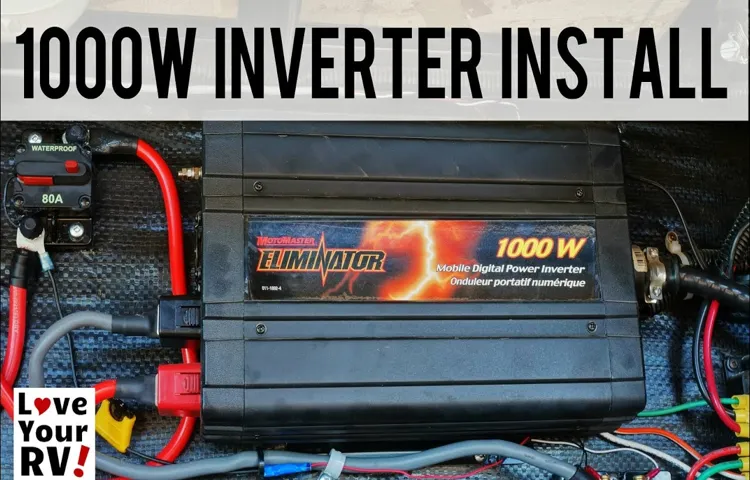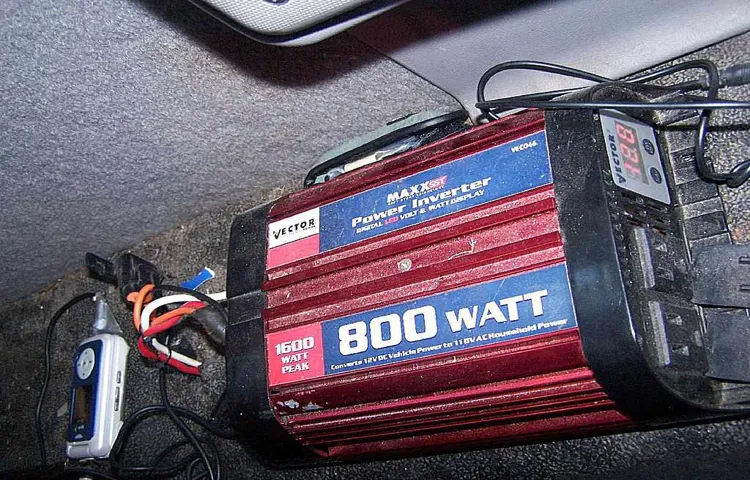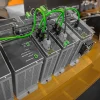Have you ever wished you could power your electronic devices while on the go? Whether you’re camping, road-tripping, or simply need to charge your laptop in the car, a power inverter is the perfect solution. With a power inverter, you can easily convert the DC power from your vehicle’s battery into AC power, allowing you to plug in and use your devices just as you would at home. But how exactly do you install a power inverter? Don’t worry, it’s easier than you might think.
In this blog post, I’m going to walk you through the step-by-step process of installing a power inverter in your vehicle. From choosing the right inverter for your needs to safely connecting it to your battery, I’ll cover all the basics so that you can start enjoying the convenience of portable power in no time. Think of a power inverter as a translator between your vehicle’s battery and your electronic devices.
It takes the low voltage DC power from your battery and converts it into the standard 120-volt AC power that most household appliances use. This allows you to plug in everything from laptops and smartphones to power tools and even small appliances. Now, you might be wondering why you can’t just plug your devices directly into your vehicle’s cigarette lighter socket.
While some devices can be powered this way, it’s not suitable for heavier loads or for devices that require a higher voltage. A power inverter, on the other hand, provides a more robust and versatile power source, making it ideal for a wide range of applications. Installing a power inverter starts with selecting the right one for your needs.
Consider factors such as wattage, surge capacity, and the number of outlets required. Once you have chosen the right inverter, you’ll need to connect it to your vehicle’s battery. This involves a few simple steps, including connecting the positive and negative cables and properly grounding the inverter.
By following these steps and taking the necessary precautions, you can safely and easily install a power inverter in your vehicle. With your new portable power source, you’ll never have to worry about running out of battery again. So let’s get started and bring the convenience of AC power wherever you go!
Table of Contents
Introduction
Are you tired of being limited to using electronic devices only when you have access to a power source? Well, installing a power inverter can solve that problem for you! A power inverter is a device that converts DC power from your car battery into AC power, allowing you to use and charge your electronic devices on the go. But how do you install a power inverter? Don’t worry, it’s easier than you might think.
Explanation of power inverters and their uses
power inverters, uses of power inverters

Importance of proper installation
Proper installation is crucial when it comes to any product or equipment. It ensures that everything is set up correctly and functions as intended. When it comes to home improvement projects, like installing a new appliance or renovating a bathroom, proper installation is even more important.
It not only ensures that everything works properly, but it also ensures the safety and longevity of the project. Without proper installation, you run the risk of things not working correctly, causing damage to your home or even potential injuries. That’s why it’s so important to take the time and effort to do things right from the beginning.
Step 1: Gather the Necessary Materials
So you’re ready to install a power inverter in your vehicle? Great! The first step is to gather all the necessary materials. Don’t worry, it’s not a long list, but it’s important to have everything on hand before you get started. First and foremost, you’ll need a power inverter.
Make sure to choose one that matches your power needs and is compatible with your vehicle. You’ll also need a grounding strap or wire to ensure the inverter is properly grounded. Additionally, you’ll need a set of cables with the appropriate connectors to connect the inverter to the battery.
It’s also a good idea to have some basic tools on hand such as a wrench, wire cutters, and electrical tape. Once you have all these materials gathered, you’ll be ready to move on to the next step in the installation process.
List of materials needed for the installation
To successfully install a new system in your home, it’s essential to gather all the necessary materials beforehand. This will ensure a smooth and efficient installation process. When it comes to creating a list of materials, it’s best to start with the basics.
You’ll need tools such as a screwdriver, pliers, wire cutters, and a voltage tester. These tools will help you safely connect and secure various components of the system. Next, you’ll need electrical wire, connectors, and electrical tape.
These materials will be used to connect the system’s components to the power source and ensure a reliable electrical connection. Additionally, you’ll need mounting brackets or screws to secure the system to the desired location. Lastly, don’t forget about any specific components or accessories that may be required for your particular system, such as sensors or control panels.
By gathering all the necessary materials in advance, you’ll be prepared and ready to tackle the installation process with confidence.
Step 2: Choose a Suitable Location
So you’ve decided to install a power inverter, but now comes the next step: choosing a suitable location. This may seem like a simple task, but it’s an important one to ensure the effectiveness and efficiency of your power inverter. First, you’ll need to consider the dimensions of the inverter and find a location where it will fit comfortably.
It’s also important to keep in mind that the inverter will generate heat, so it needs to be placed in an area with good ventilation to prevent overheating. Additionally, you’ll want to choose a location that is easily accessible for maintenance and repairs. Whether it’s under the seat of your vehicle or in your home, considering these factors will help you find the best spot for your power inverter.
Factors to consider when selecting a location for the power inverter
When it comes to selecting a suitable location for your power inverter, there are several factors that you need to consider. The second step in this process is to choose a location that best meets your needs. One important factor to consider is the proximity to the battery source.
You want to ensure that the power inverter is located as close as possible to the batteries to minimize any power loss during transmission. Another factor to consider is the ventilation of the location. Power inverters can generate heat during operation, so it is important to choose a location that has proper ventilation to prevent overheating.
Additionally, you should consider the accessibility of the location. You want to choose a location that is easily accessible for installation, maintenance, and repairs. It is also important to choose a location that is protected from the elements, such as rain, snow, and direct sunlight.
By considering these factors, you can ensure that your power inverter is installed in a suitable location that meets your needs.
Step 3: Plan the Wiring
So, you’ve decided to install a power inverter in your vehicle. Great! Now it’s time to plan the wiring. This is a crucial step to ensure that your power inverter works properly and safely.
The first thing you’ll need to do is find a suitable location to mount your power inverter. It should be placed in an area that is easily accessible for maintenance and ventilation. Make sure to choose a spot that is away from direct sunlight and any sources of heat.
Next, you’ll need to plan out the wiring. You’ll want to start by determining the length of wire you’ll need to connect your power inverter to your vehicle’s battery. Keep in mind that the longer the wire, the more voltage drop you’ll experience.
It’s always a good idea to use the shortest wire possible to minimize voltage drop. Once you have determined the length of wire you’ll need, you’ll want to route the wire in a way that avoids any potential interference with other components in your vehicle. Make sure to secure the wire using appropriate clips or ties to prevent it from coming loose or getting damaged.
When connecting the wire to your vehicle’s battery, it’s important to use the proper gauge of wire. Most power inverters will come with a recommended gauge of wire to use for a safe and efficient connection. Make sure to follow these recommendations to avoid any potential issues.
Finally, before you secure all of the wiring in place, it’s a good idea to test the power inverter to make sure everything is working properly. Connect the power inverter to your vehicle’s battery and check for any signs of overheating or abnormal noise. If everything looks good, you can go ahead and secure the wiring in place.
Considerations for routing the cables and wires
Considerations for routing the cables and wires When planning the wiring for your home or office, it’s important to consider the routing of the cables and wires that will be used. This step is crucial as it will determine the efficiency and effectiveness of your network. Firstly, you need to identify the areas where the cables and wires will need to be installed.
Take into account the layout of the space and the locations of the devices that will be connected. Think about the potential obstacles that may hinder the routing process, such as walls, furniture, or other equipment. Next, you need to decide on the best routes for the cables and wires.
Ideally, you want to have the shortest and most direct paths between the devices. This will minimize the length of the cables and wires, reducing the chances of signal loss or interference. It will also make troubleshooting and maintenance much easier in the future.
Consider the safety aspect as well. Ensure that the cables and wires are not routed in a way that they can be easily damaged or pose a tripping hazard. Keep them away from high-traffic areas and consider using cable management tools such as conduits or raceways to keep them neat and organized.
It’s also important to consider future expansion and flexibility. Plan for additional devices that may need to be connected in the future and allocate enough space for the extra cables and wires. This will save you time and effort when expanding your network down the line.
Lastly, think about the aesthetics. While functionality is key, you also want the cables and wires to look clean and unobtrusive. Conceal them behind walls, baseboards, or other decorative elements if possible.
Step 4: Disconnect the Battery
Now, we’re getting into the nitty-gritty of installing a power inverter. Step 4 involves disconnecting the battery. This step is crucial to ensure your safety while working with the electrical components.
Start by locating the battery in your vehicle, usually found in the engine compartment or trunk area. Before disconnecting the battery, it’s important to turn off the ignition and remove the key. This will prevent any electrical surges or accidents from occurring.
Once the key is removed, you can then disconnect the negative terminal of the battery by loosening the nut with a wrench. Gently lift the terminal off the battery post and secure it in a safe location, ensuring it doesn’t come into contact with any metal objects. Remember, safety first when working with electrical components, so always take the necessary precautions.
Steps to safely disconnect the battery before installation
battery disconnection, disconnecting the battery before installation Before you start installing a new battery in your vehicle, it is important to take certain safety precautions. One crucial step in this process is disconnecting the battery. This step ensures that you are not exposed to any electrical hazards while working on your vehicle.
To disconnect the battery, start by turning off the engine and removing the car keys from the ignition. Locate the battery in your vehicle’s engine compartment. You will typically find it secured with a bracket or clamp.
Use the appropriate tools to remove any bolts or fasteners holding the battery in place. Once the battery is loose, carefully lift it out of its compartment, taking care not to touch any metal surfaces or wires. It is important to note that many vehicles have two batteries – one for the engine and one for auxiliary functions.
Make sure you are disconnecting the correct battery. Finally, disconnect the negative (-) terminal first, followed by the positive (+) terminal. This sequence is important to prevent any accidental current flow or short-circuits.
Once the terminals are disconnected, you can safely remove the battery from your vehicle. This step ensures that you can carry out the installation process without any risks to yourself or your vehicle’s electrical system.
Step 5: Install the Power Inverter
So you’ve decided to install a power inverter in your vehicle. Congratulations! A power inverter is a useful device that allows you to convert the DC power from your car’s battery into AC power that can be used to operate household appliances and electronic devices. To install the power inverter, you’ll need a few tools and some basic electrical knowledge.
First, locate a suitable mounting location for the inverter, such as under the seat, in the trunk, or in the cargo area. Make sure it is easily accessible and away from any heat sources. Next, connect the inverter to the battery using appropriately sized wires and a fuse holder.
The fuse should be located as close to the battery as possible to protect against any potential electrical faults. Finally, connect the inverter to the vehicle’s electrical system, following the manufacturer’s instructions. It’s essential to ensure that the inverter is securely mounted and all connections are properly tightened to prevent any electrical hazards.
Once everything is in place, you can start enjoying the convenience of having AC power in your vehicle, whether it’s for camping trips, road trips, or just everyday use. So go ahead and give it a try – you’ll be amazed at how versatile and convenient a power inverter can be!
Step-by-step guide for installing the power inverter
Installing a power inverter is a crucial step in setting up your vehicle or home with a reliable power source. Once you have completed the previous steps of choosing the right inverter, gathering the necessary tools, and locating a suitable installation spot, it’s time to move on to the actual installation process. Step 5 involves installing the power inverter itself.
This step requires careful attention to detail and following the specific instructions provided by the manufacturer. Begin by connecting the positive and negative cables to the corresponding terminals on the power inverter. Ensure that the cables are secured tightly in place to prevent any loose connections.
Next, route the cables through the designated openings in your vehicle or home and connect them to the battery or power source. Be sure to use appropriate wire gauges and connectors to ensure a safe and efficient power transfer. Once all connections are made, double-check everything to ensure accuracy and tighten any loose connections.
Finally, test the power inverter to ensure it is functioning correctly before using it to power any devices. Installing a power inverter may seem daunting at first, but by following these step-by-step instructions, you can easily complete this important installation process.
Step 6: Connect the Wiring
Now that you have chosen the perfect power inverter for your needs and secured it in your vehicle, it’s time to connect the wiring. This step is crucial to ensure that the power inverter functions properly and safely. First, you need to locate the positive and negative terminals on your vehicle’s battery.
It’s important to disconnect the negative terminal before proceeding to avoid any electrical mishaps. Once disconnected, you can begin the wiring process. Next, identify the positive and negative terminals on the power inverter.
These terminals will typically be labeled or color-coded for easy identification. Connect the positive terminal of the power inverter to the positive terminal of the vehicle’s battery using a suitable cable or wire. Similarly, connect the negative terminal of the power inverter to the negative terminal of the vehicle’s battery.
Make sure all connections are secure and tight to avoid any loose connections or potential electrical hazards. Once the wiring is complete, you can reattach the negative terminal of the vehicle’s battery. Double-check all connections to ensure they are properly secured and there are no exposed wires or loose connections.
It is important to note that some vehicles may require additional wiring or fuse installation for the power inverter. Refer to the manufacturer’s instructions or consult a professional if you are unsure about the specific requirements for your vehicle. By properly connecting the wiring, you can ensure that your power inverter functions smoothly and provides the necessary power for your devices on the go.
Now you can enjoy the convenience of having AC power in your vehicle, whether it’s for camping trips, road trips, or any other on-the-go power needs.
Instructions for connecting the wires and cables to the power inverter
power inverter, wires and cables, connect, instructions
Step 7: Test the Inverter
Once you have successfully connected your power inverter to your battery and checked all the connections for tightness and safety, it’s time to test the inverter to make sure it’s working properly. Testing the inverter is a crucial step in the installation process, as it will determine whether or not your inverter is functioning correctly and providing the power you need. To test the inverter, start by turning on the inverter and plugging in a small electronic device, such as a phone charger or a lamp, into one of the AC outlets on the inverter.
If the device powers on and functions as expected, congratulations! Your inverter is working correctly. If the device does not power on or if there are any issues, double-check all of your connections and make sure everything is secure. You may also need to consult the user manual or contact the manufacturer for troubleshooting guidance.
Testing the inverter ensures that you have a reliable source of power when you need it, so don’t skip this important step in the installation process.
Steps to test the functionality and performance of the power inverter
power inverter, test, functionality, performance Are you ready to put your power inverter to the test? Step 7 is all about testing the inverter to ensure it is functioning properly and performing at its best. This is an important step to ensure that your power inverter is reliable and able to handle the loads you plan on using it for. So, let’s dive in and see how we can test the functionality and performance of your power inverter.
First, you’ll want to connect the inverter to a DC power source, such as a battery. Make sure the connections are secure and that the polarity is correct. Once the connections are in place, turn on the inverter and take note of any indicators or lights that come on.
These indicators can give you important information about the status of the inverter, such as whether it is on, charging, or providing power. Next, it’s time to test the functionality of the inverter. Start by plugging in a small electronic device, such as a phone charger, into one of the AC outlets on the inverter.
If the inverter is functioning properly, the device should start charging. You can also try plugging in other devices to see if they work as well. This will give you an idea of how much power the inverter can handle and what types of devices it is compatible with.
Now let’s move on to testing the performance of the inverter. You can do this by connecting a larger load, such as a power tool, to the inverter and seeing how it performs. Pay attention to how the inverter handles the load and whether it can maintain a stable power output.
If the inverter is struggling to handle the load or if the power output is unstable, it may not be suitable for your needs. It’s also a good idea to test the inverter under different conditions, such as different temperatures or loads. This will give you a better understanding of how it performs in various situations.
Conclusion
And there you have it, the enlightening tale of how to install a power inverter. With a little bit of electrical knowledge, a spark of bravery, and maybe a dash of luck, you too can transform your vehicle into a mobile powerhouse. Just remember to always put safety first, and never underestimate the power of the puns that flow through the electricity, because let’s face it, a witty installation is always a current event.
So go forth, my intrepid DIYers, and may all your journeys be powered by the vivacious voltage of your newly installed power inverter!” “And remember, while it may seem shocking at first, educating yourself on the ins and outs of electrical installations will give you the power to take charge of any car-related project. So go forth, my electrifying friends, charge up your creativity, and let your ideas surge ahead with the help of a power inverter. After all, in the electrifying journey of life, it’s always best to have a backup plan!”
Summary of the installation process and final thoughts
step 7: test the inverter, installation process, final thoughts
FAQs
What is a power inverter?
A power inverter is a device that converts DC power from a battery or solar panel into AC power that can be used to run household electronic devices.
Why would I need a power inverter?
You may need a power inverter if you are going on a camping trip or road trip and want to power your electronic devices, such as laptops, smartphones, or small appliances, using your vehicle’s battery.
Can I install a power inverter in my car?
Yes, you can install a power inverter in your car. There are different types of power inverters available, some of which are specifically designed for car installation.
How do I choose the right power inverter for my needs?
To choose the right power inverter, you should consider the power requirements of the devices you want to run, the input voltage of your battery or solar panel, and the output capacity of the power inverter.
Are power inverters safe to use?
Power inverters are generally safe to use, but it is important to follow the manufacturer’s instructions and guidelines for proper installation and usage.
Can I use a power inverter with a solar panel system?
Yes, you can use a power inverter with a solar panel system. In fact, power inverters are commonly used in solar power systems to convert DC power from the solar panels into AC power for use in the home.
How do I install a power inverter in my RV?
To install a power inverter in an RV, you will need to connect it to the battery system and ensure that it is properly grounded. It is recommended to consult the RV manufacturer or a professional electrician for guidance on the installation process.



